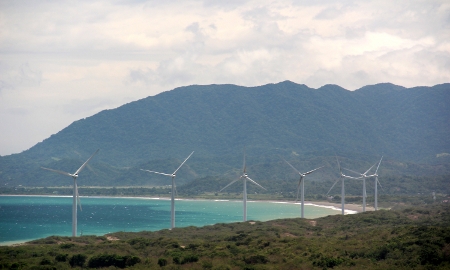With demand for power growing but supply tight and prices high, the Aquino administration knows that economic growth and national prosperity rests on the future development of the energy sector.
The 2009-2030 Philippine Energy Plan (PEP) is the government’s blueprint for energy development over the next two decades. It sees conventional fuels like oil, gas and coal remaining “indispensable”, and development of those sources is being accelerated. But, at the same time, alternative sources of energy will also be developed.
Already, approximately half of fuel inputs for power generation come from renewable sources, namely hydropower, according to the Department of Energy.
Nevertheless, the Aquino administration would like to triple its capacity in clean energy by the year 2030, for which it will need some P556.7 billion ($13.2 billion) in investment, says Energy Secretary Carlos Jericho Petilla.
Fossil fuels, of course, still hold a prominent place in the energy matrix.
Areas for exploration and development of oil, gas and coal are being offered up for bidding in an ongoing series of Philippine Energy Contract Rounds (PECRs). Through these, it is hoped to provide the country with the means to be energy self-sufficient.
The national production level target set in 2009 for oil and gas for 2030 is around 78.5 million barrels, 2,694 trillion cubic feet of gas and condensate of 87.58 million barrels.
Former Energy Secretary Jose Rene Almendras (now Cabinet Secretary to the President) believes natural gas will become a major component in the energy mix.
“As hydrocarbon supply starts going down, with 50, 75, 125 years left, we are now seeing natural gas on the upswing. I personally believe there is a lot more gas than oil in our area. Knowing that we are going to use natural gas as a major component for our energy mix five to 10 years from now, we need to build the infrastructure.”
Under PECR 4, 38 coal blocks were opened to a round of bidding, which prompted an “overwhelming” response from would-be investors. Coal production is expected to increase by up to 250%, as new companies come into the sector and existing coal operating contracts move from exploration to development.
The Philippines currently imports around 7 million tons of coal a year, around 75% of its domestic requirement; over the next 20 years, coal is expected to remain the major fuel for power generation.
The archipelago is extremely wealthy in other mineral resources, as well. In fact, it is believed to possess some of the biggest mineral reserves in the world – at least $840 billion in gold, copper, nickel, chromite, manganese, silver and iron.
Investments in exploration and mining projects totalled $3.8 billion from 2004 to 2010, and the industry generated P9.1 billion ($215.2 million) in taxes, fees and royalties in 2010, according to the Department of Environment and Natural Resources’ (DENR) Mines and Geosciences Bureau.
The Aquino administration, however, would like to further boost state revenue from the mining industry for investment in railway, highway and airport projects.
As well as increasing taxes and royalties on sales of resources, the Philippines is taking a harsher stance on corruption and illegal mining, two traits that had plagued the country’s mining industry for decades.
In eliminating illegal miners from the equation, the field will be clearer for responsible players who understand that transparency and sustainable methods will bring longer-lasting rewards, for everyone – shareholders, government and communities, alike.
The sincerity of the Aquino administration’s mining sector reforms have borne fruit in terms of international recognition. The Extractive Industry Transparency Initiative (EITI) – an internationally developed standard that ensures greater transparency and improved governance of countries’ mining resources – accepted the Philippines’ candidacy in May this year.
“When President Aquino issued Executive Order 79 [closing certain zones to mining applications], the EITI Board must have read the move as unequivocal statement of the government’s intention to implement Eiti,” said Ramon Paje, Secretary of the DENR.
The Philippines hopes to achieve EITI membership by 2015.

0 COMMENTS